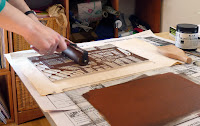At its best, April Fool's Day is a celebration of good-humored nonsense, a chance to shake things up a little and make people laugh. Apparently no one knows the origins of the tradition, although as usual Wikipedia describes some interesting possibilities. But whatever the reasons that people celebrate nonsense on the first day of April, I will celebrate in my own way by sharing the strange and wonderful stories of some nonsensical words. (And don't worry. Since it isn't actually April 1 yet, I didn't make any of these up!)
hogwash - This word began straighforwardly
enough in the 15th century as slops fed to
hogs. By the early 18th century it had come
to refer to cheap liquor, and by the end of the
18th century it meant writing without value.
enough in the 15th century as slops fed to
hogs. By the early 18th century it had come
to refer to cheap liquor, and by the end of the
18th century it meant writing without value.
guff - (1888) a puff of air, which then came to
mean "empty talk," and thus "nonsense."
mean "empty talk," and thus "nonsense."
baloney - (1922) originally meant "idiot," probably from bologna sausage, which is
made from all the odds and ends that aren't exactly of the best quality.
made from all the odds and ends that aren't exactly of the best quality.
gobbledygook - This word was apparently coined by congressman Maury Maverick in
imitation of a turkey's noise. It first appeared in 1944 in a memo banning
"gobbledygook language" in which Maverick threatened that "anyone using the
words activation or implementation will be shot." If that threat were actually
carried out there might be no one left alive in the US over the age of six.
imitation of a turkey's noise. It first appeared in 1944 in a memo banning
"gobbledygook language" in which Maverick threatened that "anyone using the
words activation or implementation will be shot." If that threat were actually
carried out there might be no one left alive in the US over the age of six.
balderdash - (1590s) originally a jumbled mix of liquors. A century later, under the
same association of ideas that worked on hogwash, it had come to mean a jumbled
mix of words. But no one knows where it came from in the first place.
same association of ideas that worked on hogwash, it had come to mean a jumbled
mix of words. But no one knows where it came from in the first place.
claptrap - (c.1720-30) a stage term for "a trick to catch applause." It had extended to
all "cheap, showy language" by the next century, and thus "nonsense."
all "cheap, showy language" by the next century, and thus "nonsense."
poppycock - (mid 19th century) Probably from a Dutch word that combined an older
Dutch word for "dung" with kak from Latin cacare "to excrete." I guess they wanted
to make doubly sure there was no mistaking their intent.
bunkum, or its shortened variant bunk - (1847) According to the Online Etymology
Dictionary, "The usual story of its origin is this: At the close of the protracted
Missouri statehood debates, on Feb. 25, 1820, N.C. Representative Felix Walker
began what promised to be a "long, dull, irrelevant speech," and he resisted calls to
cut it short by saying he was bound to say something that could appear in the
newspapers in the home district and prove he was on the job. "I shall not be
speaking to the House," he confessed, "but to Buncombe.""
I hope these words help you enjoy a little nonsensical Foolishness on April 1.
Dutch word for "dung" with kak from Latin cacare "to excrete." I guess they wanted
to make doubly sure there was no mistaking their intent.
bunkum, or its shortened variant bunk - (1847) According to the Online Etymology
Dictionary, "The usual story of its origin is this: At the close of the protracted
Missouri statehood debates, on Feb. 25, 1820, N.C. Representative Felix Walker
began what promised to be a "long, dull, irrelevant speech," and he resisted calls to
cut it short by saying he was bound to say something that could appear in the
newspapers in the home district and prove he was on the job. "I shall not be
speaking to the House," he confessed, "but to Buncombe.""
I hope these words help you enjoy a little nonsensical Foolishness on April 1.
[Picture: Catch Me!, rubber block print by AEGN, 2007 (sold out).]




























